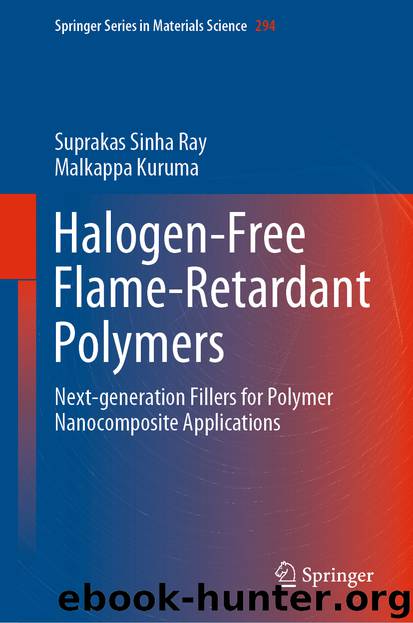Halogen-Free Flame-Retardant Polymers by Suprakas Sinha Ray & Malkappa Kuruma

Author:Suprakas Sinha Ray & Malkappa Kuruma
Language: eng
Format: epub
ISBN: 9783030354916
Publisher: Springer International Publishing
5.4 Importance and Reactivity of Diisocyanates in FR PUs
Isocyanates are one of the most important organic components in PU synthesis; they contain cumulative double bonds with N, C, and O and their structure is R–N=C=O; here, R is an aromatic, aliphatic, cyclic, or acyclic compound. Because of the industrial importance of PUs, it is necessary to study diisocyanate chemistry to understand their properties and reactivity. Due to the presence of cumulative double bonds, isocyanates are highly reactive in forming urethane groups without any by-product formation. Most of the existing isocyanate compounds containing either two or more –NCO functional groups per one molecule are called as diisocyanates and polyisocyanates, respectively. An industrially important monoisocyanate compound is methyl isocyanate (MIC), which is primarily used for pesticide manufacture, but this isocyanate is extremely hazardous and is held responsible for the 1984 Bhopal disaster. Diisocyanates exist as either liquids or solids and are highly reactive through the double bond –N=C– of the –NCO group. Aromatic diisocyanates are more reactive than aliphatic diisocyanates because of the possible resonance structures and decreased electron density on the central carbon of isocyanates, which plays an important role in controlling their reactivity. Hence, aromatic diisocyanates are more reactive than their aliphatic counterparts and can exhibit a high degree of crosslinking, which is also an important factor in improving the FR activity of polymers. Therefore, the reactivity of diisocyanates also plays an important role in FR PU synthesis; diisocyanates can lead to the formation of dimers and trimers and can also undergo self-condensation [56]. In addition, a number of crosslinking reactions may take place depending on the reactivity of the monomers and reaction conditions, such as temperature, catalysts, and the structures of the participating alcohols, amines, and isocyanates. The commonly used diisocyanates are toluenediisocyanate (TDI), 4,4′-dicyclohexylmethane diisocyanate (H12MDI), 4,4′-methylene diphenyl diisocyanate (MDI), isophorone diisocyanate (IPDI), and hexamethylene diisocyanate (HDI) [65]. The isocyanates used most often industrially are TDI and IPDI; however, compared to TDI, IPDI has some advantages as it is not toxic, has average reactivity, and is aliphatic in nature. IPDI is widely used for the preparation of light-stable PU coatings. The two isocyanate groups of IPDI exhibit different reactivities because of differences in steric hindrance and chemical environment. Different types of diisocyanates contribute to PU properties in different ways; for example, compared to cycloaliphatic or aliphatic diisocyanates, aromatic diisocyanate and polyisocyanate-containing PUs show high FR activity [119].
Download
This site does not store any files on its server. We only index and link to content provided by other sites. Please contact the content providers to delete copyright contents if any and email us, we'll remove relevant links or contents immediately.
| Automotive | Engineering |
| Transportation |
Whiskies Galore by Ian Buxton(41720)
Introduction to Aircraft Design (Cambridge Aerospace Series) by John P. Fielding(33017)
Small Unmanned Fixed-wing Aircraft Design by Andrew J. Keane Andras Sobester James P. Scanlan & András Sóbester & James P. Scanlan(32685)
Craft Beer for the Homebrewer by Michael Agnew(18082)
Turbulence by E. J. Noyes(7895)
The Complete Stick Figure Physics Tutorials by Allen Sarah(7267)
Kaplan MCAT General Chemistry Review by Kaplan(6823)
The Thirst by Nesbo Jo(6763)
Bad Blood by John Carreyrou(6477)
Modelling of Convective Heat and Mass Transfer in Rotating Flows by Igor V. Shevchuk(6354)
Learning SQL by Alan Beaulieu(6160)
Weapons of Math Destruction by Cathy O'Neil(6085)
Man-made Catastrophes and Risk Information Concealment by Dmitry Chernov & Didier Sornette(5878)
Digital Minimalism by Cal Newport;(5588)
Life 3.0: Being Human in the Age of Artificial Intelligence by Tegmark Max(5405)
iGen by Jean M. Twenge(5328)
Secrets of Antigravity Propulsion: Tesla, UFOs, and Classified Aerospace Technology by Ph.D. Paul A. Laviolette(5239)
Design of Trajectory Optimization Approach for Space Maneuver Vehicle Skip Entry Problems by Runqi Chai & Al Savvaris & Antonios Tsourdos & Senchun Chai(4957)
Electronic Devices & Circuits by Jacob Millman & Christos C. Halkias(4866)
